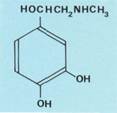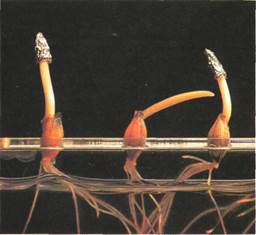
CATEGORIES:
BiologyChemistryConstructionCultureEcologyEconomyElectronicsFinanceGeographyHistoryInformaticsLawMathematicsMechanicsMedicineOtherPedagogyPhilosophyPhysicsPolicyPsychologySociologySportTourism
The metamorphic stages
of insects—such as the Gulf fritillary butterfly emerging from its pupal case—are controlled by two hormones. Juvenile hormone keeps the insect in its larval stages. Ecdysone causes an adult to develop when the level of juvenile hormone is low.
Steroidshave structures based on cholesterol (upper left box below). The similarities can be seen in the molecular diagrams below of testosterone, estradiol (an estrogen), progesterone (a progestin), norethynodrel (a synthetic progestin) and cortisone.
Biochemical messengers
Hormones are chemical messengers. They are made in minute quantities in one part of a multicellular organism. They are then transported to a target cell in another part. There, they stimulate a particular biochemical or physiological activity. In vertebrates (animals with spines), they are formed in endocrine, or ductless, glands. These glands empty directly into the bloodstream. Hormones are also known to occur in some invertebrates (not having spines), such as insects. Similar compounds, called phytohormones, control activities such as growth and flowering in plants.
Hormones are produced in such small quantities that they have proved difficult to isolate for studies on their structure and function. But modern techniques are rapidly increasing knowledge of their action on the target cells. Hormones are generally stored in an
inactive form in the cells of the endocrine glands located in the head, neck, and torso. They are released following the arrival of appropriate nerve impulses.
A hormone is carried in the blood to a receptor on the target cell. The interaction of the hormone with its receptor may then cause the release of a second messenger. This second messenger either regulates an enzyme pathway or controls the genes that code for that enzyme. The compound cyclic adenosine monophosphate (c-AMP) is involved in several different hormone activities as the second messenger. It is formed from adenosine triphosphate (ATP), the body's main energy supply. Cyclic-AMP regulates a variety of enzymes that produce cellular response. For example, it may regulate the hormone glucagon to get glycogen ready to release glucose from the liver.
Types of hormones
There are three main classes of hormones in vertebrates. They are the peptide hormones, epinephrine, and the steroids.
The peptide hormones include all those produced in the brain by the hypothalamus and pituitary glands. This class also includes two hormones—insulin and glucagon—made in the pancreas. The pancreas is located behind the stomach. Peptide hormones are proteins containing between three and about 200 amino acid residues. They are frequently active in much smaller concentrations than are other hormones. A deficiency of a particular hormone often results in disease. For example, somatotropin, or anterior pituitary growth hormone, regulates the growth of the body. Its absence causes dwarfism or retarded growth. An excess produces acromegaly, which involves excessive growth of the hands, feet, and facial bones of adults.
The second main class contains the best understood of all hormones, epinephrine. These are amine compounds, which are organic compounds derived from nitrogen. They are discussed in the article "Nitrogen compounds." Epinephrine is produced in the central (medulla) part of the adrenal glands, located above the kidneys. Epinephrine (also called adrenaline) is closely related to the nerve transmitter substance norepinephrine. This demonstrates again the interrelationship between hormonal and neural (nerve) control. Epineph-
| HO |
| C-CH |




 Cholesterol
Cholesterol
Progesterone
Testosterone
Estradiol
Cortisone
Biochemistry: Biochemical messengers 123


|

|

|
rine prepares the body for an emergency. In common with many other hormones, it acts on several different target organs. It increases the heart rate and blood pressure, releases glucose for energy from the liver, and speeds up the formation of ATP (stored-up energy) in the muscles.
The steroid hormones, the third main class, are produced in several parts of the body, including the gonads (the sex glands) and the outer layer (cortex) of the adrenal glands. Steroids are fatty compounds based on cholesterol. Because they do not dissolve in water, steroids are joined to protein molecules for transportation in the blood.
The structures of steroid hormones are very similar. But their biological effects are extremely diverse. Many are concerned with sexual functions. Examples include estrogens produced by the ovaries in females and testosterone produced by the testes in males. Steroids also have other effects on the body. The steroid cortisone is used medically to suppress the immune system, the body's natural ability to fight off disease. Male androgen hormones are used (illegally) by athletes to increase muscle size. Vitamin D is also a steroid. Following chemical modification in the body, vitamin D acts as a hormone controlling the manufacture of a protein concerned with the uptake of calcium.
Pheromones are another group of hormones with a specific function outside the body. They are scents used to attract members of the opposite sex during courtship. They also ward off rivals of the same sex. They are particularly important in insects. Some moths are able to detect the presence of a mate at a distance of several miles. There is evidence to show that pheromones are also important in higher animals.
Vitamins are a diverse group of compounds. Their only common characteristic is that they cannot be synthesized (made) by an organism. They are therefore essential ingredients in the diet. However, they are needed only in minute quantities. In the case of water-soluble vitamins, they usually perform some function together with an enzyme. Some vitamins, such as vitamin D in humans, can be produced in small amounts by the action of sunlight on the skin. The rest of the requirement has to come from food. Other organisms may not be able to produce a vitamin directly. They obtain it from another organism, for example, bacteria in the intestines obtain vitamins from the host.
Vitamins are usually classed according to their solubility (ability to dissolve) in water or in fat. The water-soluble vitamins include the B complex and vitamin C. The fat-soluble vitamins are vitamins A, D, E, and K. These compounds are needed continuously because of the breakdown of existing vitamins in the body. However, it is possible to store certain vitamins in the liver. Excessive amounts of the fat-soluble vitamins can be toxic. But a deficiency is more common. Scurvy (insufficient vitamin C), beriberi (lack of B,), and rickets (insufficient vitamin D) are all deficiency diseases.
Epinephrine(structure right) is secreted in large amounts when the body has to cope with unusual physical demands or is presented
with a potentially hazardous situation, or both (as with the skier jumping, below). The effect of the hormone is to prepare the body for "flight or fight." Epinephrine does this by increasing the heart rate, raising blood pressure, stimulating glucose release, and accelerating ATP formation.
Date: 2015-12-11; view: 3472
| <== previous page | | | next page ==> |
| Amino acid degradation and the urea cycle | | | The tips of plant shoots |